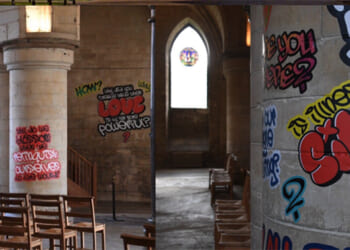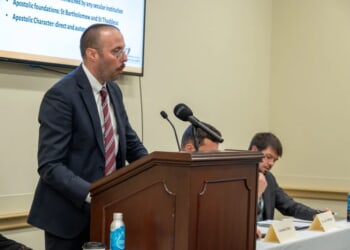
Stephen Eide joins Brian Anderson to discuss “Scandinavia on the Hudson,” his story from City Journal’s Autumn 2025 issue.
Finally, a reason to check your email.
Sign up for our free newsletter today.
Audio Transcript
Brian Anderson: Welcome back to the 10 Blocks Podcast. This is Brian Anderson, editor of City Journal, and joining me is a regular guest on the podcast Stephen Eide. He’s a senior fellow at the Manhattan Institute and a contributing editor of City Journal. Steve specializes in social policy issues including homelessness and mental illness. He was a 2024-25 public scholar at the City College of New York’s Moynihan Center, and he’s the author of Homelessness in America: The History and Tragedy of an Intractable Social Problem. Today he’s joining us to discuss his recent article from City Journal‘s Autumn issue, “Scandinavia on The Hudson,” which takes a look at New York’s ongoing experiments with social democratic policies. So Steve, thanks for coming on 10 Blocks.
Stephen Eide: Glad to be here, Ron. Thanks for asking me.
Brian Anderson: Yeah, there’s a lot of talk obviously about socialism in New York politics these days with the rise of Democratic socialists, Zohran Mamdani, and the growing influence of the Democratic Socialist Party. Generally, your essay argues that New York though is already far more social democratic than some of its leftist politicians like to admit. Yet despite massive spending on housing, education and welfare outcomes of these policies often remain poor. Why do these programs so often fail to deliver effective results? Are there structural differences, economic, cultural, or political that make what you could call the Scandinavian model hard to replicate in the us?
Stephen Eide: Yeah, I don’t know. I mean, in a sense, my essay is just one long-winded way to ask that very question because you noted I work on homelessness and I’ve had often people ask me, why do European cities look so much more orderly than American cities? And I’ve pondered what the most effective response to that question would be. And at a certain point it occurred to me that, well, one reason why Americans just don’t seem so persuaded that if we just expanded the welfare state much more generously a la Europe, we would look just like Europe is. We’ve had these little experiments such as New York City where we’ve done something like that and conditions don’t seem to be so much more orderly. Those kind of social outcomes don’t seem to be so much more impressive, and as a result, people across America think, well, New York is free to do what it wants, but it’s not as if people in Ohio or in the South are thinking, I’ll have what they’re having and therefore I’ll be just like Europe. Something is not, seems to be different about the way America does something like social democracy than what Europe does.
Brian Anderson: Well in the New York context, you catalog just this vast array supports, from Fair Fares to rent stabilization, guaranteed shelter. Given all that, would an even more social democratic New York really look that much different from the one we already have from the standpoint of a supporter of social democracy? Are we basically effectively there already in the city?
Stephen Eide: Well, I guess it depends on how you define the terms. I mean, people, certainly the progressives would say we haven’t gone far enough. But what New York does is it takes everything that the federal government does based upon the New Deal, Great Society, other programs that have built up nationally over the years. And then it layers on top of that various state and local initiatives to bring us closer to Europe. And certainly in terms of the political system, there is a strong bias towards always expansion, always doing more of what you’ve already been doing. And to some extent, that’s not even necessarily a Democratic socialist thing, I don’t think we’ve had a really small government leader in New York City for a very long time, maybe not ever. So Democratic socialism is sort of turning up to 11 these kind of political tendencies towards social policy that have been in New York City for decades by this point.
Brian Anderson: It really does raise the question of work and incentives and the middle class. You write in this essay that policy is designed to make life easier for the poor, can shift burdens onto those who are working. I wonder, could you describe a bit how that dynamic plays out in New York and it does raise the risk, doesn’t it, that the middle class, the group, which is really essential to the tax base just moves out of the city?
Stephen Eide: And I don’t think anyone is disputing that the kind of squeeze that’s on middle class New Yorkers. What does it mean to be middle class living in New York City by this point? That is a problem that’s nationwide in America, and we’ve been talking about for a long time is all kinds of implications, presidential elections, et cetera. But I think there’s this general perception that it is in fact worse in the case of New York. And so what does that mean? It seems like our late colleague, Fred Siegel was talking about this kind of top and bottom coalition, upstairs-downstairs coalition of the affluent educated classes and then the people who are dependent on government programs. That just seems to be intensifying. I mean, everything that New York keeps doing just seems to create that, make that order firmer and further. And the numbers of middle class people leaving the city in the past 10 to 15 years really speak to this.
Brian Anderson: And it’s accelerated during and after the pandemic, right?
Stephen Eide: Yeah, just holding. And whether it’s the black middle class, I mean populations who normally people thought would stay around or all middle class people, whether it’s immigrants moving directly to the suburbs moving directly south, that seemed to be the kind of most unstable socioeconomic tranche of the order in New York City, and it only seems to get worse.
Brian Anderson: The former Swedish Prime Minister you quote in the essay, Stefan Löfven described the welfare state as a trampoline. What did he mean exactly by that metaphor? And how, in your view, does New York’s version compare to that to the city’s policies really help people rebound from struggles or do they spring what Irving Kristol used to call the welfare trap?
Stephen Eide: Well, I mean, this is a good way to think about if we did what they did over there, would it work exactly like that here? And I’m familiar with Scandinavia. It is a nice place and there is something kind of conservative about the way that they think about social democracy and the way that these programs are their way of keeping things the same and keeping things just very orderly and also creating and not hindering opportunity, as you say. Well, in New York City, there is still a problem of intergenerational poverty. Intergenerational poverty is a kind of boring social problem. It was this problem that got a lot of attention back in the nineties during the welfare reform debate. We did what we could. And now then people, I think mostly moved on to other topics, but it’s still very much there in places like the South Bronx where you have very, very high rates of usage of government benefit programs and not a lot of upward mobility. So the trampoline metaphor is kind of like the last metaphor that you would apply to an experience like the South Bronx. So again, I’m just asking the question. It doesn’t seem to work that way here. I’m not exactly sure why, but that’s for other people to answer. I would say
Brian Anderson: We did go through this experiment during the Clinton years and afterwards that was quite successful of getting people off of welfare. New York was at one point a leader in that effort going from having a massive number of people in the welfare rolls to a much, much lower number, and a lot of those people get off welfare, did wind up building their lives through work. Has there been a regression in that development in recent years?
Stephen Eide: Yeah, I think a couple things happened since then, and actually next year we’re going to mark the 30th anniversary of welfare reform. And New York was an early and enthusiastic implementer of welfare reform in Giuliani and also in the Bloomberg years under Commissioner Robert Doar, where there was this idea that, well, we’re not saying that you can’t depend on any government programs. We understand that New York is a tough place to make a living. Other government reliance on government programs subsidized health insurance, but those have to be work supports. Okay? They’re building around a life to help people get into the workforce and ultimately upward mobility. De Blasio didn’t like that type of approach. He tweaked it and undermined it in various ways. And then under the Adams administration, you’d have an absolute explosion in enrollment in traditional cash assistance welfare programs. So the numbers are really rising in an impressive way, much more than the crime numbers. I mean, as complicated as the crime situation is, we’re way far away from 2,200 murders like we were at the peak crime era. Welfare has risen much more dramatically. And so I don’t know what to expect in terms of the next administration because why the dependency rate has risen under Adams, I think has a lot to do with just kind of weak administration of work requirements, et cetera. But then you’re going to have an administration come into that’s probably more ideologically in favor of expanding dependency for the sake of itself than the Adams administration was. So I think we’re poised for real growth in the welfare numbers in coming years.
Brian Anderson: One of the really interesting themes in your essay, and you started addressing this a moment ago, is the problem of cohesion. Scandinavian welfare states rest on what you would describe as an unusually high level of social trust, and they are broadly culturally homogeneous. New York, by contrast, is one of the more diverse and fragmented places in the world. So how much does that difference matter? Can social democracy really function without an underlying cultural cohesion that makes redistribution politically and socially acceptable to the broad mass of residents and citizens?
Stephen Eide: A true social democratic approach in New York City, the last thing that that would favor is something like free buses. A public transit system is a really quintessentially social democratic program. Everyone pays into the system and then everyone receives the benefits. They’re saying like, no, no, no, everyone should still use it, but who’s going to pay? I don’t know, someone else should pay. That really is not a kind of Scandinavian type of approach. And so you back into this idea, well, you just keep taxing the rich. You just keep redistributing resources from corporations and the 1 percent down to everybody else someone else has to pay. And in addition to the fact that that is, I think, socially not as impressive as the Scandinavian order, it seems like it’s going to have to hit a plateau, a real limit at a certain point because New York City, though it is still home to a number of wealthy people. It doesn’t grow billionaires at the rate it used to. And if you’re not growing the numbers of wealthy people, it’s going to be very hard to satisfy these increasing ambitions for more and more social programs on top of the pretty expensive social program that you’re already running.
Brian Anderson: Getting back to the growing democratic socialist movement in New York, how much real influence do these politicians have on city policy potentially, and how far could they push New York toward the model that they’re dreaming of? A lot of this policy environment is structured and run by the state, not the city.
Stephen Eide: You have this environment defined by the dynamics of the Democratic Party where you have a lot of centrist politicians, such as the governor, but whose principles are a little bit more uncertain, and thus they seem to be poised for a lot of intimidation from the more principled, far-left DSA politicians, this has been going on in New York politics since the 2010s, since the loss of the IDC caucus and since the just general shift left and the constant threat that democratic politicians in New York feel that they might be primaried by somebody to their left if they’re insufficiently progressive. So even if the number of centrist Democrats seem large, maybe larger than the number of very far left Democrats in terms of the way that the political system is structured, I think that the DSA and other far left members can legitimately show that they’re winning because they wield this really, really intimidating threat when elections and also just primary people may have successfully shown that they’re more organized, they’re more effective. And so it’s really incumbent on centrist Democrats to show that they are still in control of this party because I think that there’s a lot of doubt about that in New York right now.
Brian Anderson: A final question, Steve. What lessons in your view, should other American cities take from New York’s long experiment with social democratic policies? Is there any version of social democracy that could work better in the United States, given American realities?
Stephen Eide: I mean, another example, I was thinking of the cities of Vancouver and British Columbia, Canada, which seems to have just a real problem with social disorder and drugs. And Canada has a much different health insurance system than we do, but Vancouver and San Francisco seem equally messed up. Saying that if you just kind of package one kind of welfare system that has worked in one place and put it in America that you’re going to have the same effect, no one knows how that would play out, but it’s reasonable to think that it wouldn’t play out in the same way. I think that there is this path dependence question. Public transit, New York City is just going to need its public transit system in a way that other cities don’t. As I said, there’s something kind of social democratic about the way that needs to work that it’s supposed to work. So you really should in some ways double down on your social democratic systems, meaning especially the subway system in New York City. But that’s going to mean, in some cases where it works, a less socialist direction, more of a corner of centrist defined in terms of New York City framework than a far-left direction. But I don’t know if that’s the way things are going. I mean, if we seem to be actually moving away from social democracy towards socialism in New York City, then we seem to be entering really uncharted territory, I would say.
Brian Anderson: Well, Steve, thanks very much as always for joining us on 10 Blocks. The article we’ve been discussing is called “Scandinavia on the Hudson.” It’s in City Journal‘s, Autumn 2025 issue That, and Steve’s other work is available on the City Journal website. Please check out his author page, which we’ll link to in the description. And if you’ve enjoyed today’s episode, please give us a nice rating on iTunes. Steve, always great to talk with you.
Stephen Eide: Thanks, Brian.
Brian Anderson: Thanks for joining us for the weekly 10 Blocks podcast featuring urban policy and cultural commentary with City Journal editors, contributors, and special guests.
Photo by TIMOTHY A.CLARY/AFP via Getty Images
Source link

















